| [1]Cho H,Blatchley MR,Duh EJ,et al.Acellular and cellular approaches to improve diabetic wound healing. Adv Drug Deliv Rev.2018.pii: S0169-409X(18)30193-5.[Epub ahead of print][2]Kulprachakarn K,Ounjaijean S,Wungrath J,et al. Micronutrients and natural compounds status and their effects on wound healing in the diabetic foot ulcer.Int J Low Extrem Wounds.2017;16(4):244-250.[3]Ishihara J,Ishihara A,Starke RD,et al.The heparin binding domain of von Willebrand factor binds to growth factors and promotes angiogenesis in wound healing. Blood. 2019; pii: blood.2019000510. [Epub ahead of print][4]Liao HE,Shibu MA,Kuo WW,et al.Deep sea minerals prolong life span of streptozotocin-induced diabetic rats by compensatory augmentation of the IGF-I-survival signaling and inhibition of apoptosis. Environ Toxicol. 2016;31(7): 769-781.[5]Mohd Nani SZ,Majid FA,Jaafar AB,et al.Potential health benefits of deep sea water: a review. Evid Based Complement Alternat Med.2016;2016:6520475.[6]Schrameyer V,York PH,Chartrand K,et al.Contrasting impacts of light reduction on sediment biogeochemistry in deep- and shallow-water tropical seagrass assemblages (Green Island, Great Barrier Reef).Mar Environ Res.2018;136:38-47.[7]Hsu CL,Chang YY,Chiu CH,et al.Cardiovascular protection of deep-seawater drinking water in high-fat/cholesterol fed hamsters.Food Chem.2011;127(3):1146-1152.[8]Hsu TC,Chiu CC,Lin HL,et al.Attenuated effects of deep-sea water on hepatic apoptosis in STZ-induced diabetic rats.Chin J Physiol.2015;58(3):197-205.[9]Ha BG,Shin EJ,Park JE,et al.Anti-diabetic effect of balanced deep-sea water and its mode of action in high-fat diet induced diabetic mice. Mar Drugs.2013;11(11):4193-212.[10]陈玉姣,白晓苏,曾丽红.补气生肌方促进糖尿病性难愈创面血管新生和创面修复愈合的作用机制[J].实用药物与临床,2017, 20(10):1127-1130.[11]丁寅佳,崔磊,赵旭,等.富血小板纤维蛋白联合脂肪干细胞对糖尿病小鼠皮肤创面愈合的影响研究[J].中国美容医学, 2019,28(2): 8-13.[12]Choi SM,Lee KM,Kim HJ,et al.Effects of structurally stabilized EGF and bFGF on wound healing in type I and type II diabetic mice.Acta Biomater.2018;66:325-334.[13]Milan PB,Lotfibakhshaiesh N,Joghataie MT,et al.Accelerated wound healing in a diabetic rat model using decellularized dermal matrix and human umbilical cord perivascular cells. Acta Biomater. 2016; 45:234-246.[14]王志永,和晓培,薜欣,等.难愈性创面的发生机制及人工真皮在其治疗中的应用进展[J].临床合理用药杂志,2017,10(28): 180-181.[15]向鹏君,季晖,顾铭,等.糖尿病创面的炎症机制研究进展[J].药学研究,2017,36(11):667-670.[16]胡啸明,柳国斌.糖尿病足性溃疡愈合机制的研究进展[J].上海中医药杂志,2017,51(S1):217-219,223.[17]沈耀明.严重烧伤全身与局部微量元素含量变化特点及对创面修复的机制探讨[J].中国医药指南,2014, 12(34):117-118.[18]张文浩,吴起,马军,等.负压封闭引流联合肝素灌洗治疗兔烫伤并海水浸泡创面[J].南方医科大学学报,2015,35(10):1481-1486.[19]姚波,刘万宏,傅亚.影响创面愈合的营养因素研究进展[J].基因组学与应用生物学,2012,31(6):640-643.[20]张海峰,吕游,王洪莎,等.硫酸锌对糖尿病皮肤损伤的修复作用[J].中国老年学杂志,2016, 36(23):5777-5780.[21]李为明,崔进,徐鹏远,等.深层海水对小鼠创面愈合的促进作用[J].重庆医学,2014,43(4):462-464.[22]韩昌鹏,姜文成,李福伦,等. Wnt信号通路与创面愈合[J].中国美容医学,2012,21(7):1257-1260.[23]Tang H,Xu Y,Zhang Z,et al.SDF-1/CXCR4 induces epithelial?mesenchymal transition through activation of the Wnt/β?catenin signaling pathway in rat chronic allograft nephropathy. Mol Med Rep.2019;19(5):3696-3706.[24]Xie S,Fu W,Yu G,et al.Discovering small molecules as Wnt inhibitors that promote heart regeneration and injury repair.J Mol Cell Biol.2019.pii: mjz023. [Epub ahead of print][25]Leavitt T, Hu MS,Marshall CD, et al.Scarless wound healing: finding the right cells and signals. Cell Tissue Res. 2016; 365(3):483-493.[26]赵亚男,刘明,张玥,等.Wnt信号通路与皮肤创面愈合的关系[J].现代生物医学进展,2015,15(11):2173-2176,2184.[27]Yang HL,Tsai YC,Korivi M,et al.Lucidone promotes the cutaneous wound healing process via activation of the PI3K/AKT, Wnt/β-catenin and NF-κB signaling pathways. Biochim Biophys Acta Mol Cell Res.2017;1864(1):151-168.[28]Qi W,Yang C,Dai Z,et al.High levels of pigment epithelium-derived factor in diabetes impair wound healing through suppression of Wnt signaling. Diabetes.2015;64(4): 1407-1419.[29]Pizzute T,Li J,Zhang Y,et al.Fibroblast growth factor ligand dependent proliferation and chondrogenic differentiation of synovium-derived stem cells and concomitant adaptation of Wnt/mitogen-activated protein kinase signals.Tissue Eng Part A.2016; 22(15-16):1036-1046.[30]Hu F,Yan Y,Wang CW,et al.Article effect and mechanism of ganoderma lucidum polysaccharides on human fibroblasts and skin wound healing in mice. Chin J Integr Med. 2019; 25(3):203-209.[31]Ma T,Fu B,Yang X,et al.Adipose mesenchymal stem cell-derived exosomes promote cell proliferation, migration, and inhibit cell apoptosis via Wnt/β-catenin signaling in cutaneous wound healing. J Cell Biochem.2019;120(6): 10847-10854.[32]Zhang G,Song K,Yan H. MicroRNA-124 represses wound healing by targeting SERP1 and inhibiting the Wnt/β-catenin pathway.Adv Clin Exp Med.2019.[Epub ahead of print][33]Liu D, He S, Chen S, et al. Different effects of Wnt/β-catenin activation and Parathyroid hormone on diaphyseal and metaphyseal in the early phase of femur bone healing of mice. Clin Exp Pharmacol Physiol.2019.[Epub ahead of print][34]Bao Q,Chen S,Qin H,et al.An appropriate Wnt/β-catenin expression level during the remodeling phase is required for improved bone fracture healing in mice.Sci Rep.2017;7(1): 2695.[35]Rognoni E,Gomez C,Pisco AO,et al.Inhibition of β-catenin signalling in dermal fibroblasts enhances hair follicle regeneration during wound healing. Development.2016; 143(14):2522-2535.[36]Liu J,Wang Y,Pan Q,et al.Wnt/beta-catenin pathway forms a negative feedback loop during TGF-beta1 induced human normal skin fibroblast-to-myofibroblast transition. J Dermatol Sci. 2012; 65(1):38-49.[37]Schmid A,Sailland J,Novak L,et al.Modulation of Wnt signaling is essential for the differentiation of ciliated epithelial cells in human airways. FEBS Lett. 2017; 591(21):3493-3506. |
.jpg) 文题释义:
深层海水:一般指深度超过200 m的循环海水,由于光线无法到达该深度,海水水质稳定而洁净,呈弱碱性,病原菌也极少(深层海水中所含的细菌仅是表层水的千分之一至万分之一),具有低温、富含矿物质及营养成分等优点,因此应用范围较广泛,可以创造极高的附加值。日本富山、高知、冲绳等县已在海水养殖、康复、美容、饮料食品等方面取得了一系列成果,并在医学领域开展了很多研究。
Wnt信号通路:具有调控皮肤发育和毛囊生长、促进创伤皮肤血管新生及上皮重塑等功能,成为皮肤伤口愈合相关的通路之一。当Wnt通路被激活时,可抑制糖原合成酶3β(GSK-3β)的活性,阻止β-catenin发生磷酸化,进而不被泛素-蛋白酶体系降解,增加细胞内钙离子浓度并激活钙离子敏感信号成分,调节细胞运动和细胞黏着性。
文题释义:
深层海水:一般指深度超过200 m的循环海水,由于光线无法到达该深度,海水水质稳定而洁净,呈弱碱性,病原菌也极少(深层海水中所含的细菌仅是表层水的千分之一至万分之一),具有低温、富含矿物质及营养成分等优点,因此应用范围较广泛,可以创造极高的附加值。日本富山、高知、冲绳等县已在海水养殖、康复、美容、饮料食品等方面取得了一系列成果,并在医学领域开展了很多研究。
Wnt信号通路:具有调控皮肤发育和毛囊生长、促进创伤皮肤血管新生及上皮重塑等功能,成为皮肤伤口愈合相关的通路之一。当Wnt通路被激活时,可抑制糖原合成酶3β(GSK-3β)的活性,阻止β-catenin发生磷酸化,进而不被泛素-蛋白酶体系降解,增加细胞内钙离子浓度并激活钙离子敏感信号成分,调节细胞运动和细胞黏着性。.jpg) 文题释义:
深层海水:一般指深度超过200 m的循环海水,由于光线无法到达该深度,海水水质稳定而洁净,呈弱碱性,病原菌也极少(深层海水中所含的细菌仅是表层水的千分之一至万分之一),具有低温、富含矿物质及营养成分等优点,因此应用范围较广泛,可以创造极高的附加值。日本富山、高知、冲绳等县已在海水养殖、康复、美容、饮料食品等方面取得了一系列成果,并在医学领域开展了很多研究。
Wnt信号通路:具有调控皮肤发育和毛囊生长、促进创伤皮肤血管新生及上皮重塑等功能,成为皮肤伤口愈合相关的通路之一。当Wnt通路被激活时,可抑制糖原合成酶3β(GSK-3β)的活性,阻止β-catenin发生磷酸化,进而不被泛素-蛋白酶体系降解,增加细胞内钙离子浓度并激活钙离子敏感信号成分,调节细胞运动和细胞黏着性。
文题释义:
深层海水:一般指深度超过200 m的循环海水,由于光线无法到达该深度,海水水质稳定而洁净,呈弱碱性,病原菌也极少(深层海水中所含的细菌仅是表层水的千分之一至万分之一),具有低温、富含矿物质及营养成分等优点,因此应用范围较广泛,可以创造极高的附加值。日本富山、高知、冲绳等县已在海水养殖、康复、美容、饮料食品等方面取得了一系列成果,并在医学领域开展了很多研究。
Wnt信号通路:具有调控皮肤发育和毛囊生长、促进创伤皮肤血管新生及上皮重塑等功能,成为皮肤伤口愈合相关的通路之一。当Wnt通路被激活时,可抑制糖原合成酶3β(GSK-3β)的活性,阻止β-catenin发生磷酸化,进而不被泛素-蛋白酶体系降解,增加细胞内钙离子浓度并激活钙离子敏感信号成分,调节细胞运动和细胞黏着性。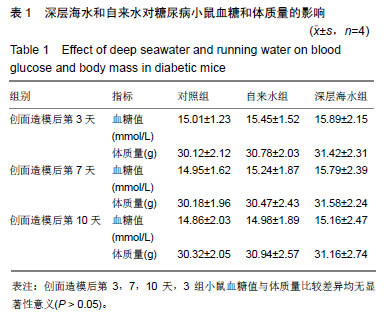
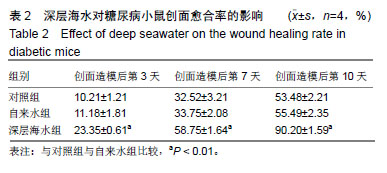

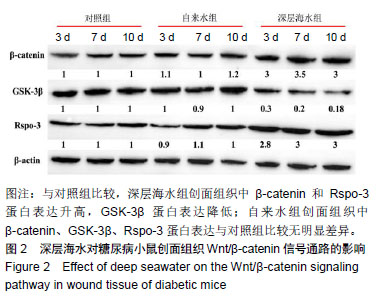

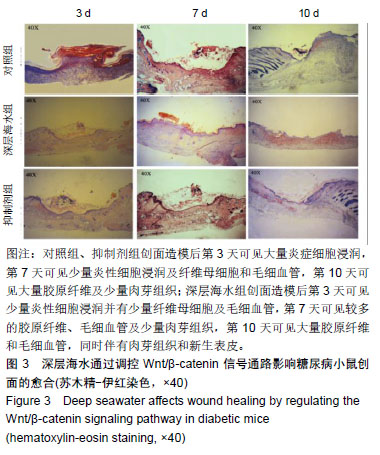
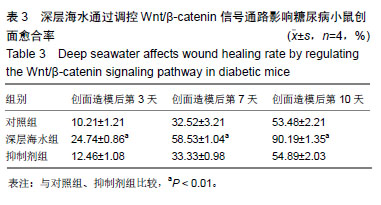

.jpg)
.jpg) 文题释义:
深层海水:一般指深度超过200 m的循环海水,由于光线无法到达该深度,海水水质稳定而洁净,呈弱碱性,病原菌也极少(深层海水中所含的细菌仅是表层水的千分之一至万分之一),具有低温、富含矿物质及营养成分等优点,因此应用范围较广泛,可以创造极高的附加值。日本富山、高知、冲绳等县已在海水养殖、康复、美容、饮料食品等方面取得了一系列成果,并在医学领域开展了很多研究。
Wnt信号通路:具有调控皮肤发育和毛囊生长、促进创伤皮肤血管新生及上皮重塑等功能,成为皮肤伤口愈合相关的通路之一。当Wnt通路被激活时,可抑制糖原合成酶3β(GSK-3β)的活性,阻止β-catenin发生磷酸化,进而不被泛素-蛋白酶体系降解,增加细胞内钙离子浓度并激活钙离子敏感信号成分,调节细胞运动和细胞黏着性。
文题释义:
深层海水:一般指深度超过200 m的循环海水,由于光线无法到达该深度,海水水质稳定而洁净,呈弱碱性,病原菌也极少(深层海水中所含的细菌仅是表层水的千分之一至万分之一),具有低温、富含矿物质及营养成分等优点,因此应用范围较广泛,可以创造极高的附加值。日本富山、高知、冲绳等县已在海水养殖、康复、美容、饮料食品等方面取得了一系列成果,并在医学领域开展了很多研究。
Wnt信号通路:具有调控皮肤发育和毛囊生长、促进创伤皮肤血管新生及上皮重塑等功能,成为皮肤伤口愈合相关的通路之一。当Wnt通路被激活时,可抑制糖原合成酶3β(GSK-3β)的活性,阻止β-catenin发生磷酸化,进而不被泛素-蛋白酶体系降解,增加细胞内钙离子浓度并激活钙离子敏感信号成分,调节细胞运动和细胞黏着性。